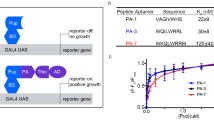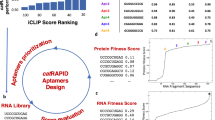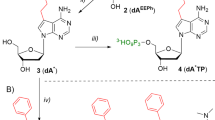Abstract
Single-stranded DNA aptamers interacting with fibrils of Saccharomyces cerevisiae Sup35p were obtained by the SELEX procedure. The specificity of interactions with Sup35p was investigated for 10 out of 40 selected aptamers. Nine aptamers were found to bind to the fibrillar but not to the monomeric form of Sup35p. The dissociation constant of the aptamer-fibril complex ranged from 0.1 to 1.0 μM for different aptamers. The aptamers can be used to study the prion transformation of Sup35p.
Similar content being viewed by others

References
Weissmann C. 2004. The state of the prion. Nature Rev. Microbiol. 2, 861–871.
Horwich A.L., Weissman J.S. 1997. Deadly conformations: Protein misfolding in prion disease. Cell. 89, 499–510.
Ter-Avanesyan M.D., Kushnirov V.V. 1999. Prions: Infective proteins with genetic properties. Biokhimiya. 64, 1638–1647.
Paushkin S.V., Kushnirov V.V., Smirnov V.N., Ter-Avanesyan M.D. 1996. Propagation of the yeast prionlike [PSI +] determinant is mediated by oligomerization of the SUP35-encoded polypeptide chain release factor. EMBO J. 15, 3127–3134.
Patino M.M., Liu J.J., Glover J.R., Lindquist S. 1996. Support for the prion hypothesis for inheritance of a phenotypic trait in yeast. Science. 273, 622–626.
Paushkin S.V., Kushnirov V.V., Smirnov V.N., Ter-Avanesyan M.D. 1997. Interaction between yeast Sup45p (eRF1) and Sup35p (eRF3) polypeptide chain release factors: Implications for prion-dependent regulation. Mol. Cell. Biol. 17, 2798–2805.
Ter-Avanesyan M.D., Kushnirov V.V., Dagkesamanskaya A.R., Didichenko S.A., Chernoff Yu.O., Inge-Vechtomov S.G., Smirnov V.N. 1993. Deletion analysis of the SUP35 gene of yeast Saccharomyces cerevisiae reveals two non-overlapping functional regions in the encoded protein. Mol. Microbiol. 7, 683–692.
Ter-Avanesyan M.D., Dagkesamanskaya A.R., Kushnirov V.V., Smirnov V.N. 1994. The SUP35 omnipotent suppressor gene is involved in the maintenance of the non-Mendelian determinant [psi +] in the yeast Saccharomyces cerevisiae. Genetics. 137, 671–676.
King C.Y., Dias-Avalos R. 2004. Protein-only transmission of three yeast prion strains. Nature. 428, 319–323.
Tanaka M., Chien P., Naber N., Cooke R., Weissman J.S. 2004. Conformational variations in an infectious protein determine prion strain differences. Nature. 428, 323–328.
Kryndushkin D.S., Alexandrov I.M., Ter-Avanesyan M.D., Kushnirov V.V. 2003. Yeast [PSI+] prion aggregates are formed by small Sup35 polymers fragmented by Hsp104. J. Biol. Chem. 278, 49636–49643.
Kushnirov V.V., Alexandrov I.M., Mitkevich O.V., Shkundina I.S., Ter-Avanesyan M.D. 2006. Purification and analysis of prion and amyloid aggregates. Methods. 39, 50–55.
Kul’bachinskii A.V. 2006. Methods for sampling aptamers for protein targets. Usp. Biol. Khim. 46, 193–224.
Glover J.R., Kowal A.S., Schirmer E.C., Patino M.M., Liu J.J., Lindquist S. 1997. Self-seeded fibers formed by Sup35, the protein determinant of [PSI +], a heritable prion-like factor of S. cerevisiae. Cell. 89, 811–819.
Bianchini M., Radrizzani M., Brocardo M.G., Reyes G.B., Gonzalez Solveyra C., Santa-Coloma T.A. 2001. Specific oligobodies against ERK-2 that recognize both the native and the denatured state of the protein. J. Immunol. Methods. 252, 191–197.
Hicke B.J., Watson S.R., Koenig A., Lynott C.K., Bargatze R.F., Chang Y.F., Ringquist S., Moon-McDermott L., Jennings S., Fitzwater T., Han H.L., Varki N., Albinana I., Willis M. C., Varki A., Parma D. 1996. DNA aptamers block L-selectin function in vivo: Inhibition of human lymphocyte trafficking in SCID mice. J. Clin. Invest. 98, 2688–2692.
Gopinath S. 2007. Methods developed for SELEX. Analyt. Bioanalyt. Chem. 387, 171–182.
Rhie A., Kirby L., Sayer N., Wellesley R., Disterer P., Sylvester I., Gill A., Hope J., James W., Tahiri-Alaoui A. 2003. Characterization of 2′-fluoro-RNA aptamers that bind preferentially to disease-associated conformations of prion protein and inhibit conversion. J. Biol. Chem. 278, 39697–39705.
Author information
Authors and Affiliations
Corresponding author
Additional information
Original Russian Text © E.R. Surina, E.V. Morozkina, A.N. Marchenko, A.A. Antipin, O.V. Mitkevich, V. V. Kushnirov, M.D. Ter-Avanesyan, S.V. Benevolensky, 2009, published in Molekulyarnaya Biologiya, 2009, Vol. 43, No. 4, pp. 682–688.
Rights and permissions
About this article
Cite this article
Surina, E.R., Morozkina, E.V., Marchenko, A.N. et al. Selection of DNA aptamers specifically interacting with the fibrillar form of the yeast Sup35 protein. Mol Biol 43, 626–631 (2009). https://doi.org/10.1134/S0026893309040153
Received:
Accepted:
Published:
Issue Date:
DOI: https://doi.org/10.1134/S0026893309040153



